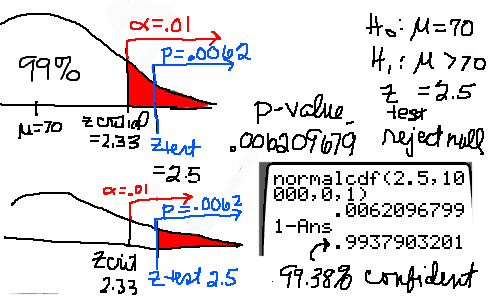|
EDIT 1:Edit... 2:SortA( 3:SortD( 4:ClrList 5:SetUpEditor |
|
CALCULATE 1:1-Var Stats 2:2-Var Stats 3:Med-Med 4:LinReg(ax+b) 5:QuadReg 6:CubicReg 7:QuadReg 8:LinReg(a+bx) 9:LnReg A:PwrReg B:Logistic C:SinReg D:Manual-Fit | Click on image to enlarge. 
|
TESTS On 1 page of notes.
For the test on the right, the following results are returned for [CALCULATE] and [DRAW].
The user must know the statistics to complete the problem. The calculator will just do the computation. See problem 2, A normally distributed standardized math test is known to have a mean of 70% and a standard deviation of 12%. The test is given to 36 freshmen and the class average is 75%. With 99% confidence, complete a hypothesis test to see if the population average is greater than 70%.
1:Z-Test... significance test for a mean, sigma known 2:T-Test... significance test for a mean, sigma unknown 3:2-SampleZ-Test... 4:2-SampleT-Test... 5:1-PropZ-Test... significance test for a proportion 6:2-PropZ-Test... significance test for the difference of two proportions 7:Z-Interval... confidence interval for a mean,known 8:TInterval... confidence interval for a mean,unknown 9:2-SampZInt... significance test for the difference of two means, sigma1 and sigma2 known 0:2-SampTInt... significance test for the difference of two means, sigma1 and sigma2 unknown A:1-ProfZInt... confidence interval for a proportion B:2-ProfZInt... confidence interval for the difference of two proportions C:  2-Test... 2-Test...  2 test of homogeneity or independence (not goodness-of-fit) 2 test of homogeneity or independence (not goodness-of-fit)
D:  2GOF-Test... 2GOF-Test...  2-Test 2-Test
E:2-SampFTest... F:LinRegTTest... significance test for a slope G:LinRegTInt... H:ANOVA( |
|
DIAGNOSTIC ON
In CATALOG toggle DiagnosticOn or DiagnosticOff to display r (correlation coefficient) and r^2 (coefficient of determination) R^2 (coefficient of determination). |

|






![[MC,i. Home]](http://www.mathnstuff.com/math/spoken/here/1gif/mcihome.gif)
![[Good Stuff]](http://www.mathnstuff.com/gif/goods.gif)


![[Words]](http://www.mathnstuff.com/math/spoken/here/1gif/words.gif)